税收学原理税收学原理思考题参考答案
- 格式:doc
- 大小:93.50 KB
- 文档页数:23
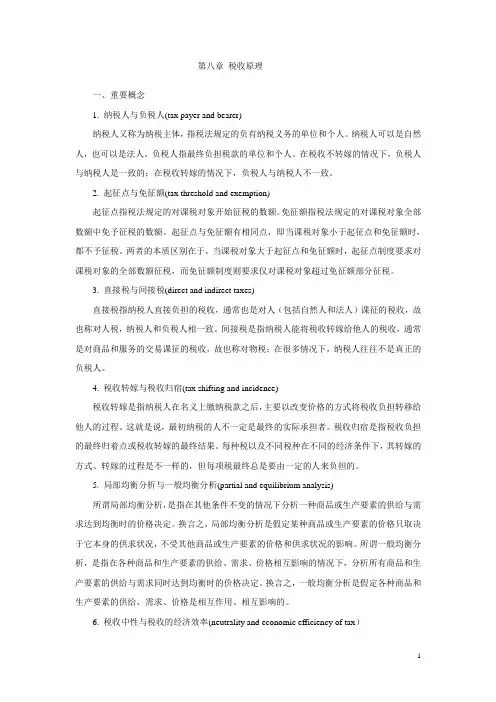
第八章税收原理一、重要概念1. 纳税人与负税人(tax payer and bearer)纳税人又称为纳税主体,指税法规定的负有纳税义务的单位和个人。
纳税人可以是自然人,也可以是法人。
负税人指最终负担税款的单位和个人。
在税收不转嫁的情况下,负税人与纳税人是一致的;在税收转嫁的情况下,负税人与纳税人不一致。
2. 起征点与免征额(tax threshold and exemption)起征点指税法规定的对课税对象开始征税的数额。
免征额指税法规定的对课税对象全部数额中免予征税的数额。
起征点与免征额有相同点,即当课税对象小于起征点和免征额时,都不予征税。
两者的本质区别在于,当课税对象大于起征点和免征额时,起征点制度要求对课税对象的全部数额征税,而免征额制度则要求仅对课税对象超过免征额部分征税。
3. 直接税与间接税(direct and indirect taxes)直接税指纳税人直接负担的税收,通常也是对人(包括自然人和法人)课征的税收,故也称对人税,纳税人和负税人相一致。
间接税是指纳税人能将税收转嫁给他人的税收,通常是对商品和服务的交易课征的税收,故也称对物税;在很多情况下,纳税人往往不是真正的负税人。
4. 税收转嫁与税收归宿(tax shifting and incidence)税收转嫁是指纳税人在名义上缴纳税款之后,主要以改变价格的方式将税收负担转移给他人的过程。
这就是说,最初纳税的人不一定是最终的实际承担者。
税收归宿是指税收负担的最终归着点或税收转嫁的最终结果。
每种税以及不同税种在不同的经济条件下,其转嫁的方式、转嫁的过程是不一样的,但每项税最终总是要由一定的人来负担的。
5. 局部均衡分析与一般均衡分析(partial and equilibrium analysis)所谓局部均衡分析,是指在其他条件不变的情况下分析一种商品或生产要素的供给与需求达到均衡时的价格决定。
换言之,局部均衡分析是假定某种商品或生产要素的价格只取决于它本身的供求状况,不受其他商品或生产要素的价格和供求状况的影响。
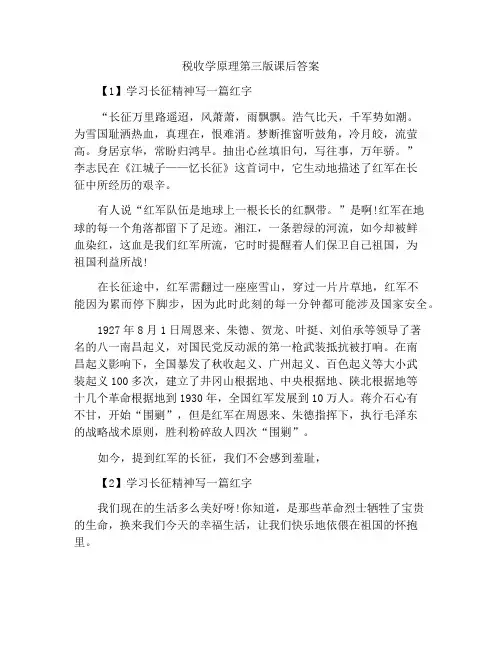
税收学原理第三版课后答案【1】学习长征精神写一篇红字“长征万里路遥迢,风萧萧,雨飘飘。
浩气比天,千军势如潮。
为雪国耻洒热血,真理在,恨难消。
梦断推窗听鼓角,冷月皎,流萤高。
身居京华,常盼归鸿早。
抽出心丝填旧句,写往事,万年骄。
”李志民在《江城子——忆长征》这首词中,它生动地描述了红军在长征中所经历的艰辛。
有人说“红军队伍是地球上一根长长的红飘带。
”是啊!红军在地球的每一个角落都留下了足迹。
湘江,一条碧绿的河流,如今却被鲜血染红,这血是我们红军所流,它时时提醒着人们保卫自己祖国,为祖国利益所战!在长征途中,红军需翻过一座座雪山,穿过一片片草地,红军不能因为累而停下脚步,因为此时此刻的每一分钟都可能涉及国家安全。
1927年8月1日周恩来、朱德、贺龙、叶挺、刘伯承等领导了著名的八一南昌起义,对国民党反动派的第一枪武装抵抗被打响。
在南昌起义影响下,全国暴发了秋收起义、广州起义、百色起义等大小武装起义100多次,建立了井冈山根据地、中央根据地、陕北根据地等十几个革命根据地到1930年,全国红军发展到10万人。
蒋介石心有不甘,开始“围剿”,但是红军在周恩来、朱德指挥下,执行毛泽东的战略战术原则,胜利粉碎敌人四次“围剿”。
如今,提到红军的长征,我们不会感到羞耻,【2】学习长征精神写一篇红字我们现在的生活多么美好呀!你知道,是那些革命烈士牺牲了宝贵的生命,换来我们今天的幸福生活,让我们快乐地依偎在祖国的怀抱里。
那些革命先烈,多么伟大呀!他们用鲜血,把五星红旗染得鲜红。
他们用生命,换来现在的和平时代。
他们的尸体掉在通往胜利的路上。
他们用自己的躯体,建造了成功的大厦。
他们的英雄事迹,记录了革命的艰辛,可他们没有放弃,他们用坚定的信念,赢得了胜利女神的眷顾,在历史上写下了光辉的一页。
就如中国最早的马克思主义者李大钊;有“砍头不要紧,只要主义真”的夏明翰;还有伟大的抗日民族英雄杨靖宇;在烈火与热血中得到永生的叶挺;生的伟大,死的光荣的刘胡兰……他们为了挽救国家的危亡,为了实现国家的富强,这些爱国志士献出了宝贵的生命,可他们的精神却永远让我们铭记在心中;尽管先烈们每一个人的生命在历史长河中,都是平凡而渺小的。
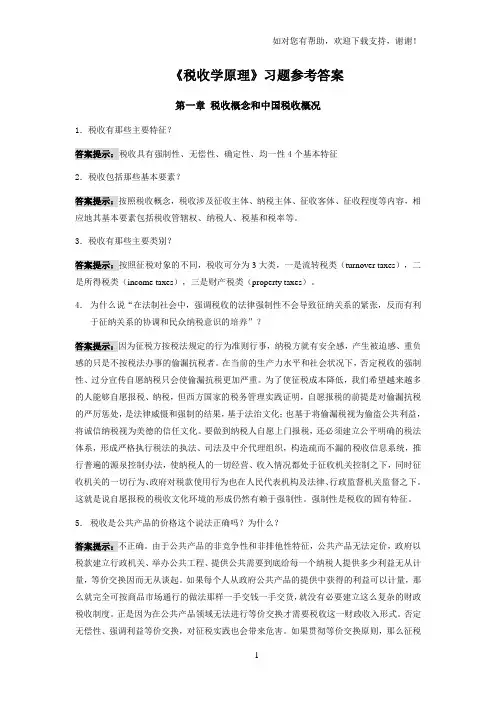
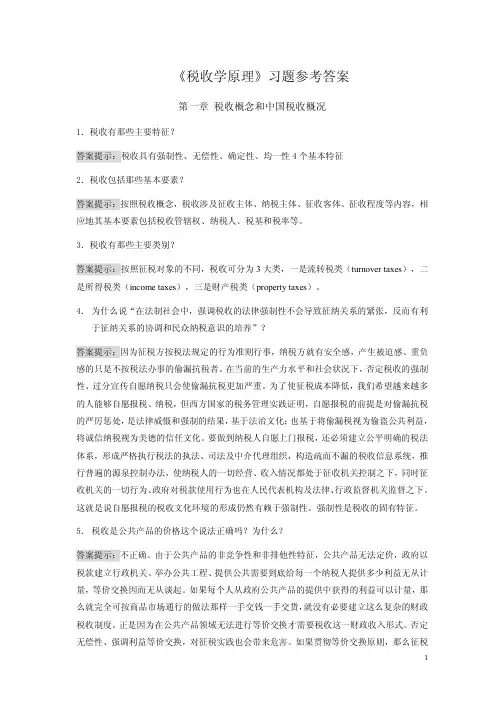
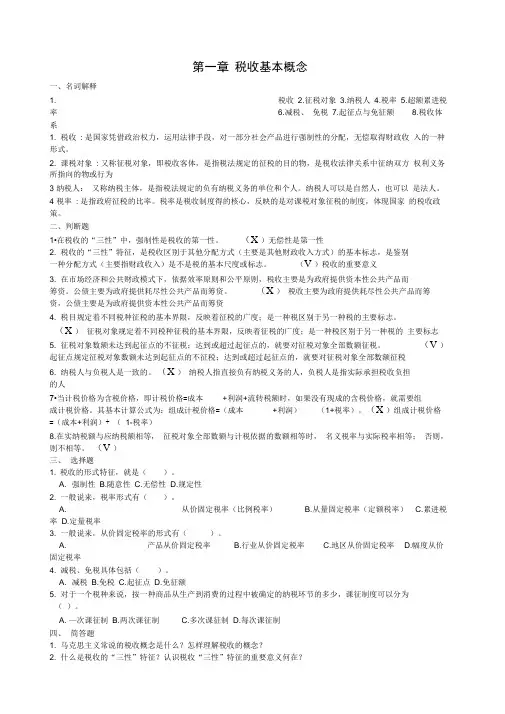
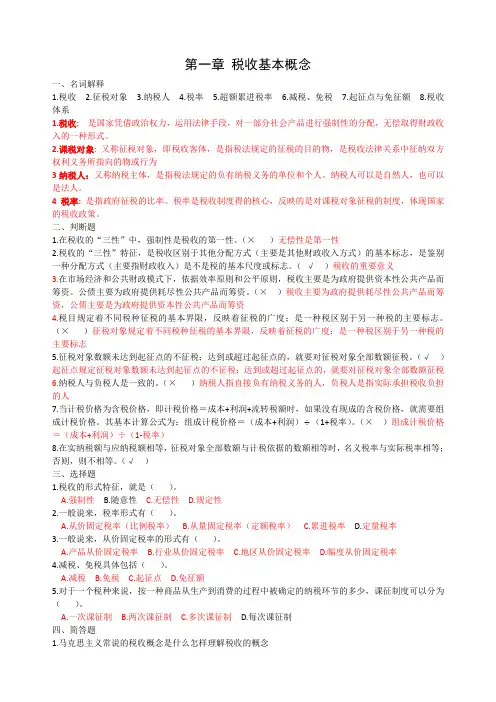
第一章税收基本概念一、名词解释1.税收2.征税对象3.纳税人4.税率5.超额累进税率6.减税、免税7.起征点与免征额8.税收体系1.税收:是国家凭借政治权力,运用法律手段,对一部分社会产品进行强制性的分配,无偿取得财政收入的一种形式。
2.课税对象: 又称征税对象,即税收客体,是指税法规定的征税的目的物,是税收法律关系中征纳双方权利义务所指向的物或行为3纳税人:又称纳税主体,是指税法规定的负有纳税义务的单位和个人。
纳税人可以是自然人,也可以是法人。
4税率:是指政府征税的比率。
税率是税收制度得的核心,反映的是对课税对象征税的制度,体现国家的税收政策。
二、判断题1.在税收的“三性”中,强制性是税收的第一性。
(×)无偿性是第一性2.税收的“三性”特征,是税收区别于其他分配方式(主要是其他财政收入方式)的基本标志,是鉴别一种分配方式(主要指财政收入)是不是税的基本尺度或标志。
(√)税收的重要意义3.在市场经济和公共财政模式下,依据效率原则和公平原则,税收主要是为政府提供资本性公共产品而筹资。
公债主要为政府提供耗尽性公共产品而筹资。
(×)税收主要为政府提供耗尽性公共产品而筹资,公债主要是为政府提供资本性公共产品而筹资4.税目规定着不同税种征税的基本界限,反映着征税的广度;是一种税区别于另一种税的主要标志。
(×)征税对象规定着不同税种征税的基本界限,反映着征税的广度;是一种税区别于另一种税的主要标志5.征税对象数额未达到起征点的不征税;达到或超过起征点的,就要对征税对象全部数额征税。
(√)起征点规定征税对象数额未达到起征点的不征税;达到或超过起征点的,就要对征税对象全部数额征税6.纳税人与负税人是一致的。
(×)纳税人指直接负有纳税义务的人,负税人是指实际承担税收负担的人7.当计税价格为含税价格,即计税价格=成本+利润+流转税额时,如果没有现成的含税价格,就需要组成计税价格。
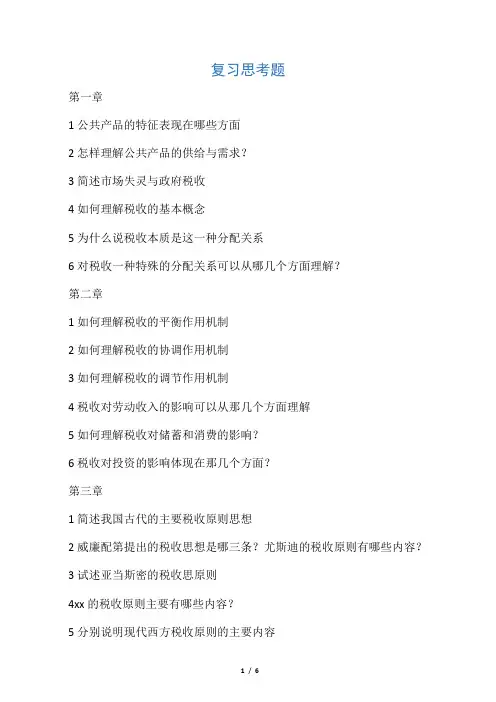
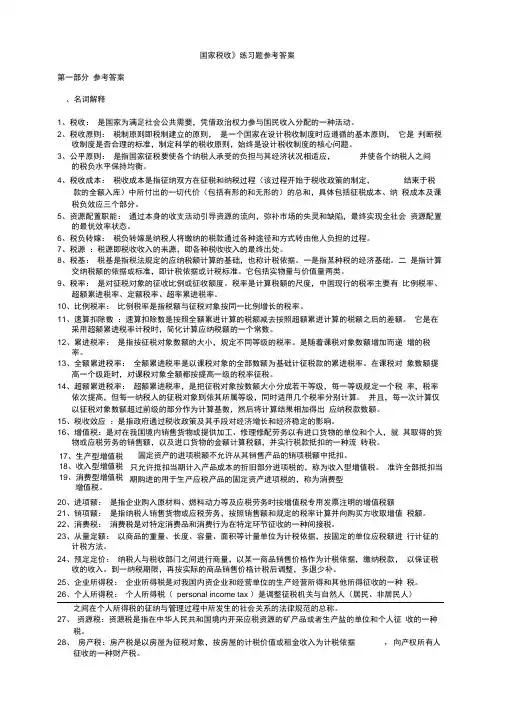
国家税收》练习题参考答案第一部分 参考答案 、名词解释1、税收: 是国家为满足社会公共需要,凭借政治权力参与国民收入分配的一种活动。
2、税收原则: 税制原则即税制建立的原则, 是一个国家在设计税收制度时应遵循的基本原则, 它是 判断税收制度是否合理的标准,制定科学的税收原则,始终是设计税收制度的核心问题。
3、公平原则: 是指国家征税要使各个纳税人承受的负担与其经济状况相适应, 并使各个纳税人之间的税负水平保持均衡。
4、税收成本: 税收成本是指征纳双方在征税和纳税过程(该过程开始于税收政策的制定,结束于税款的全额入库)中所付出的一切代价(包括有形的和无形的)的总和,具体包括征税成本、纳 税成本及课税负效应三个部分。
5、资源配置职能: 通过本身的收支活动引导资源的流向,弥补市场的失灵和缺陷,最终实现全社会 资源配置的最优效率状态。
6、税负转嫁: 税负转嫁是纳税人将缴纳的税款通过各种途径和方式转由他人负担的过程。
7、税源 :税源即税收收入的来源,即各种税收收入的最终出处。
8、税基: 税基是指税法规定的应纳税额计算的基础,也称计税依据。
一是指某种税的经济基础。
二 是指计算交纳税额的依据或标准,即计税依据或计税标准。
它包括实物量与价值量两类。
9、税率: 是对征税对象的征收比例或征收额度。
税率是计算税额的尺度,中国现行的税率主要有 比例税率、超额累进税率、定额税率、超率累进税率。
10、比例税率: 比例税率是指税额与征税对象按同一比例增长的税率。
11、速算扣除数 :速算扣除数是按照全额累进计算的税额减去按照超额累进计算的税额之后的差额。
它是在采用超额累进税率计税时,简化计算应纳税额的一个常数。
12、累进税率: 是指按征税对象数额的大小,规定不同等级的税率。
是随着课税对象数额增加而递 增的税率。
13、全额累进税率: 全额累进税率是以课税对象的全部数额为基础计征税款的累进税率。
在课税对 象数额提高一个级距时,对课税对象全额都按提高一级的税率征税。
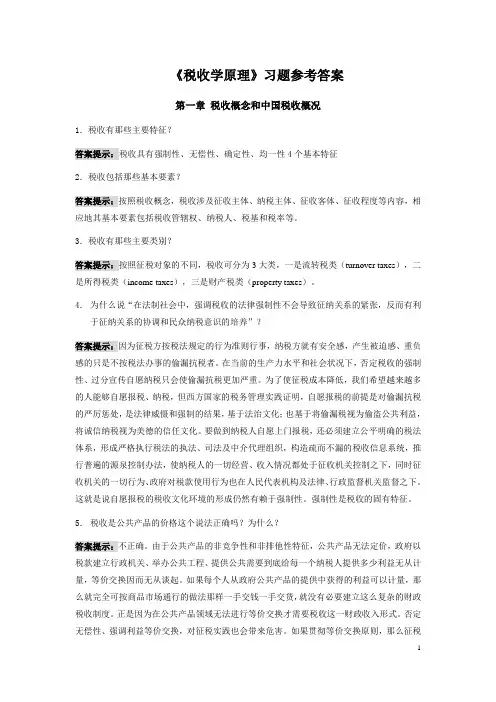
《税收学原理》习题参考答案第一章税收概念和中国税收概况1.税收有那些主要特征?答案提示:税收具有强制性、无偿性、确定性、均一性4个基本特征2.税收包括那些基本要素?答案提示:按照税收概念,税收涉及征收主体、纳税主体、征收客体、征收程度等内容,相应地其基本要素包括税收管辖权、纳税人、税基和税率等。
3.税收有那些主要类别?答案提示:按照征税对象的不同,税收可分为3大类,一是流转税类(turnover taxes),二是所得税类(income taxes),三是财产税类(property taxes)。
4.为什么说“在法制社会中,强调税收的法律强制性不会导致征纳关系的紧张,反而有利于征纳关系的协调和民众纳税意识的培养”?答案提示:因为征税方按税法规定的行为准则行事,纳税方就有安全感,产生被迫感、重负感的只是不按税法办事的偷漏抗税者。
在当前的生产力水平和社会状况下,否定税收的强制性、过分宣传自愿纳税只会使偷漏抗税更加严重。
为了使征税成本降低,我们希望越来越多的人能够自愿报税、纳税,但西方国家的税务管理实践证明,自愿报税的前提是对偷漏抗税的严厉惩处,是法律威慑和强制的结果,基于法治文化;也基于将偷漏税视为偷盗公共利益,将诚信纳税视为美德的信任文化。
要做到纳税人自愿上门报税,还必须建立公平明确的税法体系,形成严格执行税法的执法、司法及中介代理组织,构造疏而不漏的税收信息系统,推行普遍的源泉控制办法,使纳税人的一切经营、收入情况都处于征收机关控制之下,同时征收机关的一切行为、政府对税款使用行为也在人民代表机构及法律、行政监督机关监督之下。
这就是说自愿报税的税收文化环境的形成仍然有赖于强制性。
强制性是税收的固有特征。
5.税收是公共产品的价格这个说法正确吗?为什么?答案提示:不正确。
由于公共产品的非竞争性和非排他性特征,公共产品无法定价,政府以税款建立行政机关、举办公共工程、提供公共需要到底给每一个纳税人提供多少利益无从计量,等价交换因而无从谈起。
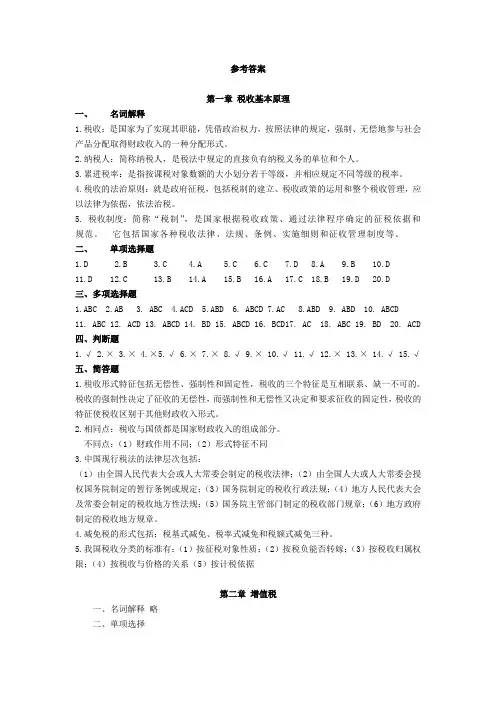
参考答案第一章税收基本原理一、名词解释1.税收:是国家为了实现其职能,凭借政治权力,按照法律的规定,强制、无偿地参与社会产品分配取得财政收入的一种分配形式。
2.纳税人:简称纳税人,是税法中规定的直接负有纳税义务的单位和个人。
3.累进税率:是指按课税对象数额的大小划分若干等级,并相应规定不同等级的税率。
4.税收的法治原则:就是政府征税,包括税制的建立、税收政策的运用和整个税收管理,应以法律为依据,依法治税。
5. 税收制度:简称“税制”,是国家根据税收政策、通过法律程序确定的征税依据和规范。
它包括国家各种税收法律、法规、条例、实施细则和征收管理制度等。
二、单项选择题1.D2.B3.C4.A5.C6.C7.D8.A9.B 10.D11.D 12.C 13.B 14.A 15.B 16.A 17.C 18.B 19.D 20.D三、多项选择题1.ABC2.AB3. ABC4.ACD5.ABD6. ABCD7.AC8.ABD9. ABD 10. ABCD11. ABC 12. ACD 13. ABCD 14. BD 15. ABCD 16. BCD17. AC 18. ABC 19. BD 20. ACD四、判断题1.√2.×3.×4.×5.√6.×7.×8.√9.× 10.√ 11.√ 12.× 13.× 14.√ 15.√五、简答题1.税收形式特征包括无偿性、强制性和固定性,税收的三个特征是互相联系、缺一不可的。
税收的强制性决定了征收的无偿性,而强制性和无偿性又决定和要求征收的固定性,税收的特征使税收区别于其他财政收入形式。
2.相同点:税收与国债都是国家财政收入的组成部分。
不同点:(1)财政作用不同;(2)形式特征不同3.中国现行税法的法律层次包括:(1)由全国人民代表大会或人大常委会制定的税收法律;(2)由全国人大或人大常委会授权国务院制定的暂行条例或规定;(3)国务院制定的税收行政法规;(4)地方人民代表大会及常委会制定的税收地方性法规;(5)国务院主管部门制定的税收部门规章;(6)地方政府制定的税收地方规章。
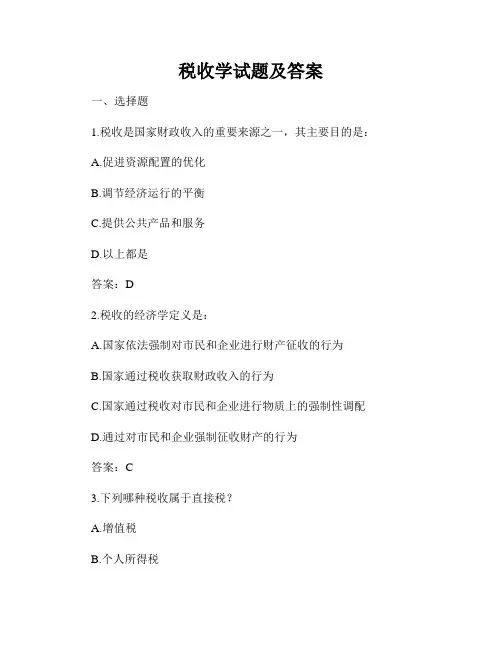
税收学试题及答案一、选择题1.税收是国家财政收入的重要来源之一,其主要目的是:A.促进资源配置的优化B.调节经济运行的平衡C.提供公共产品和服务D.以上都是答案:D2.税收的经济学定义是:A.国家依法强制对市民和企业进行财产征收的行为B.国家通过税收获取财政收入的行为C.国家通过税收对市民和企业进行物质上的强制性调配D.通过对市民和企业强制征收财产的行为答案:C3.下列哪种税收属于直接税?A.增值税B.个人所得税C.消费税D.企业所得税答案:B4.税务征管的主要任务是:A.制定税法法规B.征收和管理税收C.监督税收使用D.推动税收改革答案:B5.税基是税收征收的对象,下列不属于税基的是:A.个人收入B.增值税销售额C.企业利润D.消费金额答案:D二、填空题1.税务登记是纳税人依法申请并取得税务登记证书的过程,主要用于________。
答案:纳税人身份识别和纳税信用管理。
2.税前扣除是指纳税人在计算应纳税额之前,按照税法规定从收入中扣除的项目。
例如,教育、医疗、住房等专项扣除可以减少纳税人的________。
答案:纳税额。
3.税法是国家对纳税人的权利和义务进行规范的法规,税法规定了税收的种类、征收方式、纳税义务等内容。
税法的遵守是纳税人的________。
答案:法定义务。
4.税收逃避是指纳税人以非法手段逃避或减少应缴纳的税款,其中包括逃避税款的________、骗取、转移税务机关不能执行的。
答案:报税。
5.税务稽查是税务机关对纳税人的纳税情况进行核实的一种监管方式,其目的是维护税收秩序、增强纳税人的纳税诚信度,并惩罚那些进行________行为的。
答案:违法。
三、简答题1.请简要介绍税收的分类和主要特点。
答:税收可以分为直接税和间接税。
直接税是指由纳税人直接承担和交纳的税,如个人所得税和企业所得税。
间接税是指由生产或交易中间环节的纳税人代表消费者缴纳的税,如增值税和消费税。
税收的主要特点包括强制性、普遍性、公平性和收入弹性。
Chapter 6Questions and Problems for Discussion1. a. The annual business cycle for a plant and garden center might end in the late autumnindicating an October 31 or November 30 fiscal year end.b. A bakery has no obvious annual business cycle to suggest a particular taxable year.c. The annual cycle for a chimney cleaning business might end in late spring indicating anApril 30 fiscal year end, or the cycle might end in early autumn indicating a September30 fiscal year end.d. The annual cycle for a moving and transport business might end in late summerindicating an August 31 fiscal year end.e. A software consulting business has no obvious annual cycle to suggest a particulartaxable year.2. Corporation DB can elect a different overall method of accounting for each of its threebusiness ventures.3. This lucky event increased Firm LK’s net worth by $72,000 and, therefore, resulted in$72,000 recognized income to the firm.4. If the two corporations have different marginal tax rates, an intercompany transaction couldresult in a shift of income from the high tax entity to the low tax entity or a shift of adeduction from the low tax entity to the high tax entity. A method of accounting thataccomplishes such a shift and does not reflect an arm’s length transaction price between the related corporations is highly vulnerable to IRS challenge.5. Firms that provide audited financial statements to external users (investors, creditors,regulatory agencies, etc.) must prepare the statements in accordance with GAAP. The SEC requires publicly held corporations to follow GAAP in the preparation of financialstatements.6. No, the cash method does not require that the taxpayer receive currency. The receipt ofproperty (such as the case of wine) triggers income recognition based on the value of the property.7. Evidently, the increase in the after-tax cost of business lunches reduced KJ Inc.’s demandfor the service provided by Al’s Steak House. To the extent that the restaurant’sprofitability declined because of the aggregate reduction in demand by the businesscommunity, the restaurant’s owners bear the incidence of the indirect tax increase.8. The death benefits received by a corporate beneficiary under its key-person life Insurancepolicies are nontaxable. Therefore, the cost associated with the nontaxable income (the annual premiums on the policies) is nondeductible by the corporation. In contrast, if other parties (the officer’s spouse and children) are named as beneficiaries, the premiums paid by the corporation represent additional officers’ compensation, which is a deductiblebusiness expense.9. Under GAAP, income is not realized until earned. If a firm receives payment for goods orservices to be provided in a future year, the prepayment is recorded in a liability account as unearned revenue. Under the tax law, many prepayments of income must be included in taxable income, even if the income has not yet been earned. The GAAP treatment isconservative because it prevents an overstatement of book income. The tax treatment is conservative because it prevents an understatement of taxable income (financial ability to pay).10. a. Taxable income exceeds book income by $55 (disallowed 50 percent of meal expense).b. Book income exceeds taxable income by $700 ($3,500 tax-exempt interest $2,800nondeductible interest expense).c. Taxable income exceeds book income by $17,400 ($7,400 nondeductible lobbyingexpenses + $10,000 nondeductible political contribution).11. Under the cash method, income from the provision of goods and services is not recognizeduntil payment for the goods and services is received, an event that usually occurs after the income is earned under the accrual method. Thus, the cash method results in deferral from the year income is earned until the year payment is received. In a growing business, this annual deferral results is continuous. Therefore, in NPV terms, the tax cost associated with the cash method is less than the tax cost associated with the accrual method, even though each method results in the same total income recognition over the life of the business. 12. A deferred tax asset is similar to a prepaid tax resulting from an excess of taxable incomeover book income. The asset creates no independent value for the firm. A deferred taxliability is similar to a deferred tax resulting from an excess of book income over taxable income. The liability has no independent cost to the firm.13. A net operating loss suggests that a business is losing money. Most unprofitable businessventures don’t last for 20 years.14. A tax preference may take the form of an income item reported for financial statementpurposes but never included in gross income, or a tax deduction that is not based on an expense or loss reported for financial statement purposes. The resulting book/taxdifferences are permanent differences, which are more valuable than temporary differences in NPV terms.Application Problems1. a. Nello must recognize the $8,400 excess of the account payable over the settlementpayment ($23,400 - $15,000) as discharge-of-debt income. Nello’s tax cost of theincome is $2,940 ($8,400 × 35%), and its net cash outflow is $17,940 ($15,000 cashpaid + $2,940 tax cost).b. Bonview can deduct the $8,400 excess of the account receivable over the settlementpayment ($23,400 - $15,000) as a bad debt. Nello’s tax savings from the deduction is$2,520 ($8,400 × 30%), and its net cash inflow is $17,520 ($15,000 cash received +$2,520 tax savings).2. a. PT’s tax on $92,000 income is $19,530 ($13,750 + 34% [$17,000 excess income over$75,000]).b. In this case, PT must annualize the $92,000 income reported on the short-period return.$92,000 short-period income ⨯ (12 months ÷ 4 months) = $276,000 annualized income.The tax on $276,000 annualized income is $90,890 ($22,250 + 39%[$176,000 incomeover $100,000]). This tax must be deflated to reflect the four months of operations inthe short period.$90,890 ⨯ (4 months ÷ 12 months) = $30,297.3. a. Because the property and casualty insurance premium is deductible, the after-tax cost is$3,640 ($5,600 – [$5,600 × 35%]).b. Because the fine is nondeductible, the after-tax cost is $1,200.c. Because the life insurance premium is nondeductible, the after-tax cost is $3,700.d. Because the political contribution is nondeductible, the after-tax cost is $50,000.e. Because only 50 percent of the entertainment expense is deductible, the after-tax cost is$6,435 ($7,800 – [$3,900 × 35%]).4. Northwest Company is allowed a domestic production activities deduction equal to 6% ofnet income generated by the Portland plant. Consequently, its taxable income is computed as follows.Net income from Portland plant $3,100,000Net income from Vancouver plant 4,800,000Domestic production activities deduction(6% × $3,100,000) (186,000)Taxable income $7,714,0005. a. $22 taxable income. Although Firm B received $522 cash, the $500 principal repaymentwas a nontaxable return of investment. Only the $22 interest is income.b. No taxable income. Although Firm B received $600 cash, the receipt created a liabilityfor repayment of the deposit and did not increase net worth.c. No taxable income. Although Firm B received $10,000 cash, the receipt created aliability for repayment of the loan and did not increase net worth.d. $888 taxable income. Although Firm B earned only $180 of the prepaid rent this year,(15 days in December × $12), the income is recognized in the year payment is received.6. a. The recording of the account receivable had no effect on Firm F’s taxable income.b. The write-off of the account receivable had no effect on Firm F’s taxable income.7. Although Firm Q is a cash basis taxpayer and received only $10,000 cash, it recognizes the$23,400 total value of the cash and noncash payment as taxable income.8. a. As a cash basis taxpayer, RTY recognizes no income for the services performed and$4,000 prepaid rent income.b. As an accrual basis taxpayer, RTY recognizes $17,800 income for the servicesperformed and $4,000 of prepaid rent income.9. a. No deduction. The $50,000 results in a benefit extending beyond the following taxableyear and must be capitalized.b. No deduction. Brillo must use the accrual method to account for purchases ofinventory. Thus, the $79,000 is capitalized to inventory.c. No deduction. The $1,800 cost of the refrigerator is capitalized to an asset account.d. $4,800 deduction.e. $22,300 deduction.10. a. Even though NC adopted the cash method as its overall method of accounting, it mustuse the accrual method to account for inventory purchases. Therefore, its cost of goods sold for its first taxable year is $254,400 ($319,000 purchases $64,600 inventory onhand at year-end), and it is using a hybrid method of accounting.b. $254,400 (no difference)11. a. LSG can deduct the entire $9,450 expenditure in 2009, the year of payment, because theexpenditure results in a benefit with a duration of less than 12 months and the benefitdoes not extend beyond 2010.b. LSG must capitalize the $9,450 expenditure because it results in a benefit with aduration of more than 12 months. LSG can amortize the capitalized expenditure at arate of $525 per month ($9,450 ÷ 18 months), and can amortize and deduct $1,050 in2009 ($525 × 2 months).12. a. Even as a cash basis taxpayer, Firm F can deduct only $4,720 of the interest payment(the interest relating to the four-month period from September 1 through December31).b. $4,720 (no difference)13. a. Under the cash method of accounting, Wahoo must recognize the entire $36,000prepayment as 2009 income.b. Even as an accrual basis taxpayer, Wahoo must recognize the entire $36,000prepayment as 2009 income.14. a. GreenUp should report $20,000 revenue in 2009, $65,000 revenue in 2010, and $15,000revenue in 2011 for financial statement purposes.b. Under the one-year deferral method, GreenUp must recognize $20,000 taxable incomein 2009 and $80,000 taxable income in 2010.15. Cornish cannot deduct an accrued expense that fails the all-events test. Cornish’s liabilityfor the accrued expense is fixed because it has a binding contract with the constructioncompany. The $65,000 amount of the accrual is an estimate; only $7,200 (the billed amount) is determinable with reasonable accuracy. Economic performance with respect to the$7,200 accrual has occurred because the construction company has provided the services to Cornish. Consequently, Cornish’s current year deduction is limited to $7,200.16. a. If KLP uses the cash method of accounting, it can deduct $100,000 in the year ofpayment.b. For financial statement purposes, KLP must accrue a $100,000 expense in the year thewinner was selected and its liability to pay the prize became fixed. However, because of the economic performance requirement for awards, prizes, or jackpots, KLP is notallowed a tax deduction until the year of payment.17. a. Economic performance with respect to Ernlo’s liability for the purchased oil does notoccur until the oil is delivered in October. Consequently, Ernlo can deduct the $12,450cost in its fiscal year ending June 30, 2010.b. Under the recurring item exception, Ernlo can deduct the $12,450 cost in its fiscal yearending June 30, 2009, because economic performance (delivery) occurred within 8½months after the close of the year.18. a. Economic performance with respect to HomeSafe’s liability for future service callsdoes not occur until HomeSafe provides the service. Consequently, HomeSafe cannotdeduct any of the $48,900 accrued expense in 2009. In 2010, it can deduct the $36,300cost of the service calls provided in 2010 (484 service calls × $75 cost per call).b. Under the recurring item exception, HomeSafe can deduct $27,150 of the $48,900accrued expense in 2009 (362 service calls made within 8½ months after the close of2009 × $75 cost per call). It can deduct $9,150 in 2010 (122 service calls made fromSeptember 16 through December 31 × $75 cost per call).19. a. BZD can deduct the $55,000 accrued compensation expense in 2009 because thecompensation was paid by March 15, 2010 (2½ months after year-end).b. BZD can deduct $20,000 of the $40,000 accrued bonus expense: the amount paid byMarch 15, 2010. The $20,000 bonus payment made on May 1, 2010, is deductible in2010.c. BZD cannot deduct any of the $219,700 accrued vacation pay expense because none ofthe expense was paid by March 15, 2010. BZD will deduct the expense in the year ofpayment.20. a. Deduction for accrued expense in 2008 $180,000Tax rate .352008 tax savings $63,000PV of 2010 payment($180,000 ⨯ .873 discount factor at 7%) (157,140)NPV of after-tax cost $(94,140)b. After-tax cost in 2010($180,000 payment - $63,000 tax savings) $(117,000)NPV of after-tax cost ($117,000 ⨯ .873 discount factor at 7%)$(102,141)21 a. Economic performance with respect to Extronic’s liability for state income tax occurswhen the tax is paid. Consequently, Extronic can deduct the $273,900 tax paid during2009 ($41,900 balance due of 2008 tax + $232,000 estimated tax payments).b. Under the recurring item exception, Extronic deducted the $41,900 accrued expensefor 2008 tax in 2008 because the liability was paid within 8½ months after the close of2008. It can deduct the $19,200 accrued 2009 expense because the liability was paidwithin 8½ months after the close of 2009. Consequently, Extronic’s 2009 deductionfor state income tax is $251,200 ($232,000 estimated tax payments + $19,200 accruedtax payable).22. a. Company N can deduct the $7,740 interest payment in 2010, the year in which relatedparty Creditor K recognized the payment as income.b. Company N can deduct the $7,740 interest expense in 2009. Even though Creditor K isa related party, it recognized the payment as income in 2009 under its accrual method ofaccounting.c. Company N can deduct the $7,740 interest expense in 2009 because Company N andCreditor K are unrelated.23. a If Mrs. T owns no Acme stock, she and Acme are not related parties. Thus, Acme candeduct the $20,000 bonus in 2009, the year in which the expense was accrued.b. If Mrs. T owns 63 percent of Acme’s stock, she and Acme are related parties. Thus,Acme must wait to deduct the $20,000 bonus until 2010, the year in which Mrs. Tincludes the payment in income.24. a. GK’s bad debt expense for financial statement purposes is $90,000, which is theaddition to the allowance for bad debts.b. GK’s tax deduction for bad debts is $77,300, the amount of actual write-offs ofaccounts receivable.25. a. For financial statement purposes, the $65,000 write-off was charged against theallowance for bad debts and did not reduce financial statement income. For taxpurposes, the $65,000 write-off was deducted in the computation of taxable income.b. For financial statement purposes, the $65,000 recovery was credited to the allowancefor bad debts and did not increase financial statement income. For tax purposes, the$65,000 recovery was included in taxable income under the tax benefit rule.26. EFG’s net book income before tax $500,000Bad debt expense per books $12,500Bad debt deduction (write-offs) (13,800)(1,300)Nondeductible fine 17,500Nondeductible contingent liability 50,000Advanced payment for inventory no differenceEFG’s taxable income $566,20027. a. 35% × $31,000 excess of book income over taxable income = $10,850 deferred taxliabilityb. No deferred tax asset or liability from permanent book/tax difference.c. 35% × $55,000 excess of taxable income over book income = $19,250 deferred taxasset28. a. GT’s tax expense is $238,000 (34% × $700,000 book income).b. GT’s tax payable is $275,400 (34% × $810,000 taxable income).c. The excess of tax payable over tax expense is a $37,400 net increase in deferred taxassets.29. a. Net income before tax $600,000Permanent book/tax differences 15,000$615,000Tax rate .34Corporation H’s tax expense $209,100b. Taxable income $539,000Tax rate .34Corporation H’s tax payable $183,260c. Tax expense $209,100Tax payable (183,260)Net increase in deferred tax liabilities $25,84030. a. Net income before tax $378,200Permanent book/tax differences (33,500)$344,700Tax rate .34Corporation H’s tax expense $117,198b. Taxable income $457,100Tax rate .34Corporation H’s tax payable $155,414c. Tax payable $155,414Tax expense (117,198)Net increase in deferred tax assets $38,216 31. Micro’s net book income before tax $505,100Domestic production activities deduction(6% × $319,600) (19,176) Prepaid royalty income 40,000Accrued bonus expense no differenceNOL carryforward deduction (21,400) Micro’s taxable income $504,52432. TRW’s taxable income for the eight-year period is computed as follows:2001 2002 2003 20042005 2006 2007 2008 Tax. income beforeNOL deduction20,000 158,000 81,000 (741,000)21,000 398,000 687,000 905,000 NOL deduction (158,000) (81,000) NA (21,000) (398,000) (83,000)Taxable income 20,000 -0- -0- -0- -0- 604,000 905,00033. a. 34% × $90,000 unfavorable temporary difference = $30,600 deferred tax assetb. 34% × $710,000 NOL carryforward = $241,400 deferred tax assetc. Negative tax expense $272,000 ($30,600 + $241,400). Negative tax expense can also becomputed by multiplying Rony’s $800,000 book loss by its 34 percent tax rate.34. a. Rony’s tax expense is $408,000 (34% × $1,200,000 book income).b. Rony’s tax payable is $136,000 (34% × $400,000 taxable income).c. Rony’s reduction in its deferred tax assets is $272,000.Issue Recognition Problems1. Must Corporation DS recognize the $15,000 discharged debt as income, even though thecancellation did not increase the insolvent corporation’s net worth?2. Is the discovery of the underlying painting a realization event that triggers $249,700 incomefor the theater company? Did the discovery of the underlying painting merely increase the value of the asset purchased for $300, an increase that does not represent realized income?3. Is BL Inc. required to request permission from the IRS to change from an incorrect to acorrect method of accounting?4. In which year (2009 or 2010) does Company A recognize the $160,000 income from theconsulting engagement? Because Company A used the cash method in 2009 (when theconsulting engagement was completed) and the accrual method in 2010 (when the cash was received), does the $160,000 income from the consulting engagement escape taxationentirely?5. Was Mr. RJ in constructive receipt of the $3,500 income in the earlier year because he couldhave picked up the check from the client’s receptionist if he had checked his phonemessages during the holidays?6. Assuming that Maxo accrues a liability for the $14,420 bill from the publisher, can it deductthe accrued expense? Does an accrued liability fail the all-events test if the taxpayer notifies the creditor that it is contesting the amount of the liability?7. Is $75,000 an arm’s length price for the advertising provided by HT to LT? Did HTundercharge for the service rendered to LT to shift income to a related party with a zero marginal tax rate?8. Does the $18,000 property tax refund represent either financial statement income or taxableincome to Firm K?9. Should Firm G have recognized $200,000 or only $150,000 income in 2007? If Firm Grecognized $200,000 income in 2007, can it deduct the $30,000 settlement paid in 2009? If Firm G recognized $200,000 income in 2007, can it request a $11,700 refund ($30,000 ⨯ 39 percent), or must it be content with a $10,200 tax savings from a 2009 deduction ($30,000 ⨯34 percent)?10. Can a taxpayer choose the carryback year in which an NOL is deducted or must an NOLcarryback be deducted in chronological order?11. Can BL deduct TM’s NOL carryforwards? If a taxpayer purchases a business thatgenerated NOL carryforwards, does the purchaser acquire the carryforwards along with all the other business properties?Research Problems1. Section 458 provides a special method of accounting available to publishers and distributorsof magazines, paperback books, and musical records, tapes, and discs. According to Section 458(a), accrual basis taxpayers can exclude the income realized on sales of these items that are returned before the close of the “merchandise return period.” According to Section 458(b)(7), the merchandise return period for magazines is the two-month and 15-day period after the close of the taxable year. According to Section 458(b)(6), the income excluded is limited to the refund paid by the taxpayer for the returned items. Based on these rules,Bontaine Inc. can exclude $82,717 (refund paid in January 2010 for December 2009 sales) from its 2009 taxable income.2. In CharlesSchwab Corp. v. Commissioner, 107 T.C. 282 (1996), aff’d, 161 F.3d 1231 (CA-9, 1998), cert. denied (1999), the Tax Court and the Ninth Circuit Court of Appeals held that discount brokerage houses must accrue commission income on the earlier trade date instead of the later settlement date. Based on this decision, CheapTrade should recognize $1,712,400 commission income in 2009.3. The answer to this research problem depends on whether Moleri has made an election underSection 461(c) and Reg. Sec. 1.461-1(c) to accrue real property tax ratably over the twelve months of the calendar year to which the tax relates. If this election is in effect, Molerideducts $17,395 (7 months × [$29,820 ÷ 12 months]) of the 2009 tax on its return for the fiscal year ending July 31, 2009. It also deducts the 5 months of its 2008 property taxpayment relating to August through December 2008. If this election is not in effect, Moleri deducts the entire 2009 tax because it paid the tax (i.e. economic performance occurred) during the year. Reg. Sec. 1.461-4(g)(6)(iii)(A).4. This case is based on U.S. Freightways Corp. v. Commissioner, 270 F. 3d 1137 (CA-7, 2001),rev’g 113 TC 329 (1999). The accrual basis freight company deducted its entire annual payment for permits and licenses, even when the annual term of the permit or licenseextended into the following year. The company based this accounting treatment on the regulatory rule allowing a deduction for prepaid expenses providing a benefit that does not extend substantially beyond the end of the year following the year of payment. The IRS argued that this “12-month” rule applied only to cash basis taxpayers. Although the Tax Court agreed with the IRS, the Seventh Circuit reversed the Tax Court and allowed the deduction. This decision paved the way for Reg. Sec. 1.263(a)-4(f) (promulgated on December 31, 2003), paragraph (f) of which provides a 12-month rule applying to both cash and accrual basis taxpayers. Under this regulation, Jetex Inc. can deduct $1,119,200 in 2009.Tax Planning Cases1. The net income deferred from 2009 until 2010 through use of the cash method iscomputed as follows.Accrual method:Income from billings $3,500,000Expenses incurred (800,000)Net income in 2009 $2,700,000Cash method:Cash received $2,900,000Expenses paid (670,000)Net income in 2009 (2,230,000)Income deferred until 2010 under cash method $470,000The value of this deferral is computed as follows.Tax on income deferred one year($470,000 ⨯ 34%) $159,800NPV of deferred tax($159,800 ⨯ .935 discount factor at 7%) (149,413)Decrease in tax cost from cash method $10,3872. a. Yes. VB’s positive taxable income in 2007 indicates that the corporation either carriedback its 2006 NOL or claimed it as a carryforward deduction in 2007.b. VB’s carryback of $170,000 of the 2009 NOL would generate the following refund.Tax paid in 2007 $10,000Tax after $60,000 NOL carryback -0-Refund $10,000Tax paid in 2008 $26,150Tax after $110,000 NOL carryback -0-Refund 26,150Total refund received $36,150The NPV of VB’s remaining $180,000 NOL carryforward into 2011 is computed asfollows.NOL carryforward deduction $180,000Projected 2011 marginal tax rate .34Projected tax savings from deduction $61,200NPV of tax savings($61,200 ⨯ .873 discount factor at 7%) $53,428The total value of the 2009 NOL is $89,578 ($36,150 + $53,428).c. The NPV of a $350,000 NOL carryforward into 2011 is computed as follows.NOL carryforward deduction $350,000Projected 2011 marginal tax rate .34Projected tax savings from deduction $119,000NPV of tax savings($119,000 .873 discount factor at 7%) $103,887To maximize the value of the NOL deduction, VB should give up the carryback and carry the 2009 NOL forward as a deduction to 2011.。
第一章税收基本概念一、名词解释1.税收2。
征税对象3。
纳税人 4.税率 5.超额累进税率 6.减税、免税7.起征点与免征额8.税收体系1。
税收:是国家凭借政治权力,运用法律手段,对一部分社会产品进行强制性的分配,无偿取得财政收入的一种形式.2。
课税对象: 又称征税对象,即税收客体,是指税法规定的征税的目的物,是税收法律关系中征纳双方权利义务所指向的物或行为3纳税人:又称纳税主体,是指税法规定的负有纳税义务的单位和个人。
纳税人可以是自然人,也可以是法人。
4税率:是指政府征税的比率。
税率是税收制度得的核心,反映的是对课税对象征税的制度,体现国家的税收政策.二、判断题1.在税收的“三性”中,强制性是税收的第一性。
(×)无偿性是第一性2.税收的“三性”特征,是税收区别于其他分配方式(主要是其他财政收入方式)的基本标志,是鉴别一种分配方式(主要指财政收入)是不是税的基本尺度或标志。
(√)税收的重要意义3.在市场经济和公共财政模式下,依据效率原则和公平原则,税收主要是为政府提供资本性公共产品而筹资。
公债主要为政府提供耗尽性公共产品而筹资。
(×)税收主要为政府提供耗尽性公共产品而筹资,公债主要是为政府提供资本性公共产品而筹资4.税目规定着不同税种征税的基本界限,反映着征税的广度;是一种税区别于另一种税的主要标志。
(×)征税对象规定着不同税种征税的基本界限,反映着征税的广度;是一种税区别于另一种税的主要标志5.征税对象数额未达到起征点的不征税;达到或超过起征点的,就要对征税对象全部数额征税。
(√)起征点规定征税对象数额未达到起征点的不征税;达到或超过起征点的,就要对征税对象全部数额征税6.纳税人与负税人是一致的。
(×)纳税人指直接负有纳税义务的人,负税人是指实际承担税收负担的人7.当计税价格为含税价格,即计税价格=成本+利润+流转税额时,如果没有现成的含税价格,就需要组成计税价格。
第一章税收基本概念参考答案一、名词解释1.是国家凭借政治权力,按照法律规定的对象和标准,非惩罚性地参与社会剩余产品价值分配的一种方式。
2.亦称“课税对象”或“课税客体”,是指对什么征税,即征税的标的物或行为。
3.是纳税义务人的简称,即税法上规定的直接负有纳税义务的单位和个人,亦称纳税主体。
4.是税法上对征税对象或税目从价或从量规定的征收比率或征收额度。
5.即征税对象数额的超过部分按照与之相适应的等级的税率征税。
6.是对某些纳税人或征税对象给予减轻或免予征税的一种激励和照顾的优惠措施。
7.起征点:即征税对象数额达到开始征税的起点,亦称起税点。
征税对象数额未达到起征点的不征税;达到或超过起征点的,就要对征税对象全部数额征税。
免征额:即征税对象总额中免予征税的数额。
无论征税对象总额是多少,其中免征额都是不征税的,仅就超过免征额的部分征税。
8.亦称税收系列,简称税系,是指按一定标准设计和归纳不同税种而形成的相互联系的税收逻辑结构。
二、判断题1.×,无偿性是税收的第一性。
2.√3.×,税收主要是为政府提供耗尽性公共产品而筹资。
而公债则主要是为政府提供资本性公共产品而筹资。
4.×,征税对象规定着不同税种征税的基本界限,反映着征税的广度;是一种税区别于另一种税的主要标志。
5.√6.×,纳税人与负税人并不完全是一回事。
纳税人是指直接负有纳税义务的人。
负税人是指实际承担税收负担的人,或者说是税负承担者。
7.×,组成计税价格=(成本+利润)÷(1-税率)8.√三、选择题1.ACD2.ABC3.ABCD4.ABCD5.ABC四、简答题1.答:(1)马克思主义学说的税收概念认为:税收是国家凭借政治权力,按照法律预定的对象和标准,非惩罚性地参与社会剩余产品价值分配的一种方式。
(2)税收概念的理解:第一,税收的主体是国家。
税收总是一定社会形态下的国家的税收,所以,税收也称为国家税收。